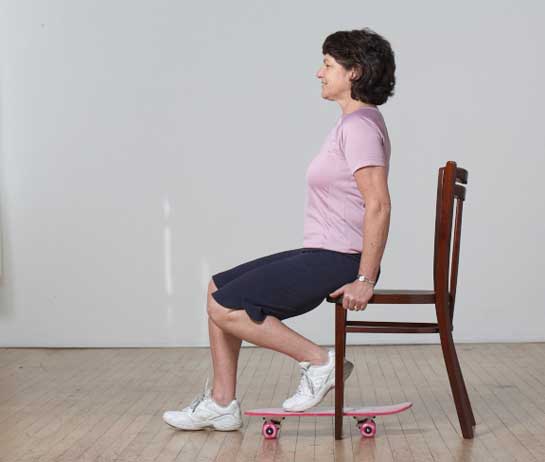BY NICHOLAS A. DINUBILE, M.D.
Q: I work with a client who is about to undergo cartilage regeneration surgery in her knee to try to regrow the joint cushion. Can you give me some information about this procedure and recommend some post-rehabilitation exercises that I can use to help facilitate her return to exercise?
A: We have now entered the era of regenerative (as opposed to reparative) orthopedic surgery, which means that we can sometimes actually regenerate damaged tissue or structures, including joint cushions. I cover this quite extensively in my book, Framework for the Knee, and it is very exciting for knee surgeons and their patients alike. There are several procedures that can be used to try to regrow injured or damaged knee cushions, and the two that I most commonly perform are microfracture surgery and autologous chondrocyte implantation or transplantation (ACI).
Microfracture surgery, developed by my friend and one of my mentors, Dr. Richard Steadman in Vail, Colo., is a relatively simply arthroscopic outpatient procedure that counts on the body’s own stem cells to patch the damaged area. ACI, on the other hand, is a more involved open surgery in which the patient’s own cartilage cells are actually implanted after having been grown in the laboratory.
In both types of surgery, the recovery is relatively slow and a staged progressive rehabilitation program is critical and every bit as important as the surgery itself. Often, patients have more difficulty with the post-operative restrictions and rehabilitation than the actual surgery. People don’t like restrictions placed upon them, especially if they (and their knee) are feeling well, but this is one time when the body can be deceiving. The patient might feel well pretty quickly, but the inside of her knee is not ready for prime time.
It takes tremendous patience, but failure to follow the recommended protocol can result in suboptimal results. Both surgeries involve a period of approximately eight to 12 weeks of limited weight bearing, and crutches or a brace, depending on the location of the repaired damage (kneecap versus femoral condyle). For the first three or four weeks, passive motion of the knee helps regrow the cushion. A CPM (continuous passive motion) machine is often prescribed for six to eight hours per day. For people who don’t have a large chunk of time or insurance coverage for CPM, I substitute the “skateboard slide” (below) that I came up with as I talked on the phone and my foot rocked back and forth on my son Dylan’s skateboard. (Your client can purchase a child-size mini-skateboard for less than $5.00 at discount stores and simulate the CPM use by rocking the leg/knee back and forth.)
While your client should follow the specific rehabilitation program recommended by her physician, additional information on rehabilitation programs after microfracture surgery can be found at Dr. Steadman’s Web site.


The FrameWork Fix
Once your client has been given her physician’s green light to begin exercising, she can start with some basic recovery exercises, such as those described below, before progressing to using the elliptical machine and incorporating aquatic and strength-training exercises. Ideally, recovery exercises should be done daily, even several times a day, until normal strength and/or flexibility are regained and the client is feeling good. Urge your client to listen to her body and self-monitor for any significant discomfort or other changes that might signal a problem. I do not recommend high-impact loading like running or sports for approximately nine months because the newly formed joint cushion needs adequate time to mature and become more durable. During the knee recovery period, the client can continue to strengthen the opposite leg and work on core and upper-extremity strength and flexibility. (Note: These exercises can be used with clients following arthroscopic surgeries as well.)
Be aware that the full cycle of knee cushion regrowth and maturation can take up to two years, so both you and your client must be extremely patient. Hopefully this process will be accelerated with new cell therapies that are on the horizon.


Lock-and-Lift Isometrics
Have the client lie on her back with her left knee bent and the left foot resting on the floor. Next, she should tighten and slowly lock the right thigh (pushing back with the right knee). Be sure the quadriceps muscles—particularly the vastus medialis obliquus—are contracted and firm. Next, she should lift the right leg 6 to 8 inches off the floor and hold for five to seven seconds, maintaining the contraction in the quad. This exercise can be performed 12 to 15 times and repeated with the opposite leg, if needed. Once the exercise becomes too easy, add light ankle weights to increase the challenge.


Knee Range-of-Motion
Have the client sit on a mat with legs extended in front and the heel of her recovering knee resting on a phone book or foam block. Have her gently press downward on the knee until it is full extended and hold for five seconds. Next, have her flex the knee and gently pull the heel toward the buttocks, holding for the same count. Urge her to improve her range motion a little in each session. This exercise helps regain lost motion and mobility and can be performed multiple times per day, especially if the knee is stiff.
______________________________________________________________

Nicholas A. DiNubile, M.D., is an orthopedic surgeon specializing in sports medicine, a best-selling author, and ACE’s chief medical advisor. He has served as orthopedic consultant to the Philadelphia 76ers and the Pennsylvania Ballet, and his award-winning television special, Your Body’s FrameWork, has been aired on PBS nationwide. Learn more about Dr. DiNubile at DrNick.com.